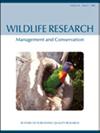The potential distribution of the yellow monitor, Varanus flavescens (Hardwick & Gray) under multiple climate, land cover and dispersal scenarios in Nepal
IF 1.6
3区 生物学
Q3 ECOLOGY
引用次数: 3
Abstract
ABSTRACT Context. Human-induced changes in climate and land cover have altered the distribution of fauna around the globe. Some reptiles have been found to be vulnerable to these changes; therefore, studies to identify the impact of the changes on other groups of reptiles are necessary. Aims. We aimed to study the impact of climate and land cover change on the yellow monitor (Varanus flavescens) in Nepal. We also aimed to identify the current distribution range and predict the potential distribution under multiple climate change, corresponding land cover change, and dispersion scenarios in the near- and mid-future. Methods. We used available presence locations with a candidate set of the least-correlated environmental variables and an Ensemble of Small Models (ESM), a Species Distribution Model (SDM) approach suitable for species with small sample size. Additionally, dispersal scenarios of 1 km, 5 km, and 10 km were added to the model to determine the future distribution under the dispersal scenarios. Key results. We found soil particle size, distance to forest, precipitation of wettest quarter, bulk density, and elevation were the five most important variables contributing to the distribution of the species. The Terai lowland and wide valleys in Outer Himalayas are currently suitable but are expected to experience a substantial decrease under most future climate projections and dispersal scenarios. Conclusions. The distribution is mostly dependent on soil-related variables; however, climatic variables might have a greater impact on future suitability. Implications. Limiting emissions contributing to climatic changes, conserving the soil outside the protected areas, and the potential areas where the species will not experience habitat loss might contribute to the conservation of the species.在尼泊尔多种气候、土地覆盖和扩散情景下,黄鼠Varanus flavescens (Hardwick & Gray)的潜在分布
本文章由计算机程序翻译,如有差异,请以英文原文为准。
求助全文
约1分钟内获得全文
求助全文
来源期刊

Wildlife Research
生物-动物学
CiteScore
4.30
自引率
15.80%
发文量
56
审稿时长
3 months
期刊介绍:
Wildlife Research represents an international forum for the publication of research and debate on the ecology, management and conservation of wild animals in natural and modified habitats. The journal combines basic research in wildlife ecology with advances in science-based management practice. Subject areas include: applied ecology; conservation biology; ecosystem management; management of over-abundant, pest and invasive species; global change and wildlife management; diseases and their impacts on wildlife populations; human dimensions of management and conservation; assessing management outcomes; and the implications of wildlife research for policy development. Readers can expect a range of papers covering well-structured field studies, manipulative experiments, and analytical and modelling studies. All articles aim to improve the practice of wildlife management and contribute conceptual advances to our knowledge and understanding of wildlife ecology.
Wildlife Research is a vital resource for wildlife scientists, students and managers, applied ecologists, conservation biologists, environmental consultants and NGOs and government policy advisors.
Wildlife Research is published with the endorsement of the Commonwealth Scientific and Industrial Research Organisation (CSIRO) and the Australian Academy of Science.
 求助内容:
求助内容: 应助结果提醒方式:
应助结果提醒方式:


